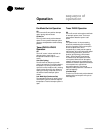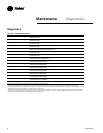
UNT-SVX07A-EN 53
Operation
sequence of
operation
Tracer ZN520 Sequence of
Operation
The Tracer ZN520 operates the fan in the
following modes:
1) occupied
2) unoccupied
3) occupied standby
4) occupied bypass
5) Tracer Summit with supply fan control
Occupied
When the controller is in the occupied
mode, the unit attempts to maintain the
space temperature at the active occupied
heating or cooling setpoint, based on the
measured space temperature, the
discharge air temperature, the active
setpoint, and the proportional/integral
control algorithm. The modulating control
algorithm used when occupied or in
occupied standby is described in the
following sections. Additional information
related to the handling of the controller
setpoints can be found in the previous
Setpoint operation section.
Unoccupied Mode
When the controller is in the unoccupied
mode, the controller attempts to maintain
the space temperature at the stored
unoccupied heating or cooling setpoint,
based on the measured space
temperature, the active setpoint and the
control algorithm, regardless of the
presence of a hardwired or
communicated setpoint. Similar to other
configuration properties of the controller,
the locally stored unoccupied setpoints
can be modified using Rover™ service
tool.
In unoccupied mode, a simplified zone
control algorithm is run. During the
cooling mode, when the space tempera-
ture is above the cool setpoint, the
primary cooling capacity operates at
100%. If more capacity is needed, the
supplementary cooling capacity turns on
(or opens to 100%). During the heating
mode, when the space temperature is
below the heat setpoint, the primary
heating capacity turns on. All capacity is
turned off when the space temperature is
between the unoccupied cooling and
heating setpoints. Note that primary
heating or cooling capacity is defined by
unit type and whether heating or cooling
is enabled or disabled. For example, if
the economizer is enabled and possible, it
will be the primary cooling capacity. If
hydronic heating is possible, it will be the
primary heating capacity.
Occupied Standby Mode
The controller can be placed into the
occupied standby mode when a
communicated occupancy request is
combined with the local (hardwired)
occupancy binary input signal. When the
communicated occupancy request is
unoccupied, the occupancy binary input
(if present) does not affect the controller’s
occupancy. When the communicated
occupancy request is occupied, the
controller uses the local occupancy
binary input to switch between the
occupied and occupied standby modes.
During occupied standby mode, the
controller’s economizer damper position
goes to the economizer standby mini-
mum position. The economizer standby
minimum position can be changed using
Rover service tool.
In the occupied standby mode, the
controller uses the occupied standby
cooling and heating setpoints. Because
the occupied standby setpoints typically
cover a wider range than the occupied
setpoints, the Tracer
ZN520 controller
reduces the demand for heating and
cooling the space. Also, the outdoor air
economizer damper uses the econo-
mizer standby minimum position to
reduce the heating and cooling demands.
When no occupancy request is commu-
nicated, the occupancy binary input
switches the controller’s operating mode
between occupied and unoccupied.
When no communicated occupancy
request exists, the unit cannot switch to
occupied standby mode.
Occupied Bypass Mode
The controller can be placed in occupied
bypass mode by either communicating
an occupancy request of Bypass to the
controller or by using the timed override
On button on the Trane zone sensor.
When the controller is in unoccupied
mode, you can press the On button on the
zone sensor to place the controller into
occupied bypass mode for the duration of
the bypass time (typically 120 minutes).
Occupancy Sources
There are four ways to control the
controller’s occupancy:
• Communicated request (usually
provided by the building automation
system or peer device)
• By pressing the zone sensor’s timed
override On button
• Occupancy binary input
• Default operation of the controller
(occupied mode)
A communicated request from a building
automation system or another peer
controller can change the controller’s
occupancy. However, if communication is
lost, the controller reverts to the default
operating mode (occupied) after 15
minutes (configurable, specified by the
“receive heartbeat time”), if no local
hardwired occupancy signal exists.
A communicated request can be pro-
vided to control the occupancy of the
controller. Typically, the occupancy of the
controller is determined by using time-of-
day scheduling of the building automation
system. The result of the time-of-day
schedule can then be communicated to
the unit controller.
Tracer Summit with Supply Fan Control
If the unit is communicating with Tracer
Summit and the supply fan control
programming point is configured for
Tracer (the factory configures as local),
Tracer Summit will control the fan
regardless of the fan mode switch
position.
When the fan mode switch is set to Off or
when power is restored to the unit, all
Tracer ZN520 lockouts (latching diagnos-
tics) are manually reset. The last diagnos-
tic to occur is retained until the unit power
is disconnected. Refer to Trane publica-
tion,
CNT-SVX04A-EN Tracer ZN520
Installation Operation and Programming
Guide
, for specific instructions regarding
the procedure for running the Tracer
ZN520.


















